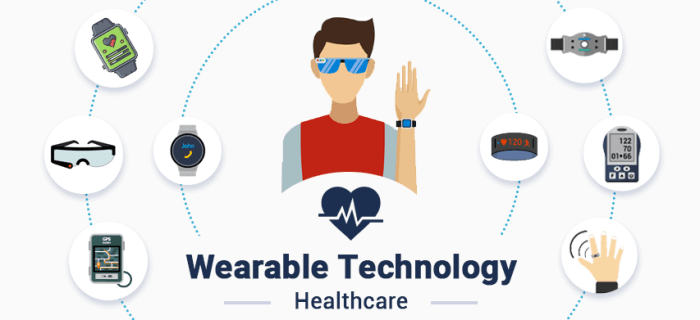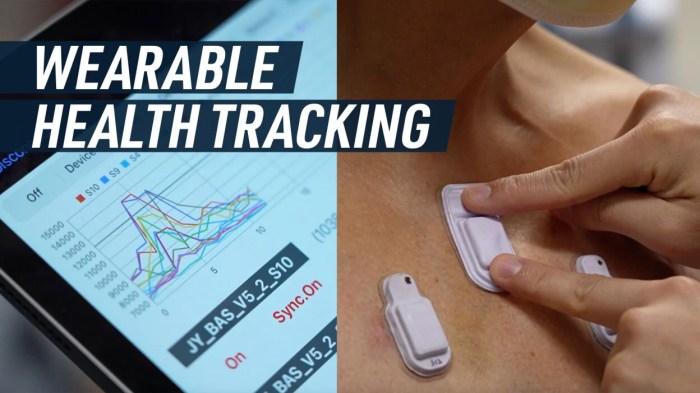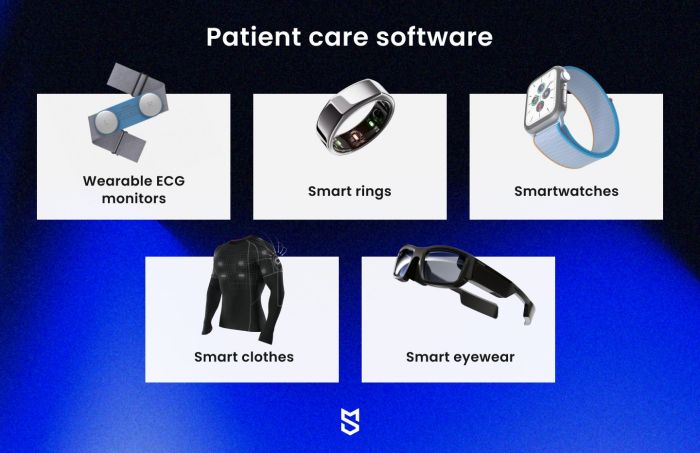Wearable Health: Advanced Biometric Trackers are revolutionizing how we monitor and manage our well-being. From basic activity trackers to sophisticated smartwatches, these devices have come a long way, boasting impressive biometric capabilities. They collect a wealth of data, including heart rate, sleep patterns, and activity levels, offering valuable insights into our health and potentially helping us prevent illness. This deep dive explores the evolution of these trackers, the cutting-edge technology behind them, their practical applications, and the crucial considerations surrounding data security and privacy.
This exploration delves into the intricate details of how these advanced trackers work, examining the sensors, algorithms, and overall design that allows them to collect and process information with increasing precision. We’ll also look at the various ways these trackers are used for personal health monitoring, and the role they play in promoting healthier lifestyles.
Advanced Biometric Tracking Capabilities: Wearable Health: Advanced Biometric Trackers

Source: techrecur.com
Ever wondered how those fancy biometric trackers work? Wearable health tech is seriously stepping up its game, offering super precise data on your well-being. But while you’re tracking your heart rate and sleep, why not also focus on boosting your home aesthetic? Check out some seriously stylish home accents under $50, like these cool, budget-friendly finds Decorating on a Dime: Stylish Home Accents Under $50 , to create a space that’s both beautiful and reflects your health journey.
Ultimately, both a great home and a healthy body are key to a great life! These health trackers are a cool addition to your well-being toolkit.
Beyond basic steps and heart rate, today’s wearable trackers are diving deep into the complexities of our bodies. They’re not just counting steps; they’re analyzing patterns, offering insights into our health, and paving the way for personalized wellness strategies. This evolution relies on a sophisticated blend of cutting-edge technology and sophisticated algorithms.
These advanced trackers are moving beyond rudimentary measurements to offer more comprehensive and nuanced data about our physical well-being. This allows for a deeper understanding of our bodies, enabling personalized insights and proactive health management. They’re no longer just gadgets; they’re becoming valuable tools for monitoring and understanding our health.
Technological Advancements in Precise Biometric Measurements
Modern wearable trackers leverage several key technological advancements to achieve higher accuracy in biometric measurements. Miniaturization of sensors and improved signal processing techniques are crucial. Advancements in materials science have led to more sensitive and reliable sensors that can capture data with increased precision. This allows for more accurate and comprehensive assessments of various physiological parameters.
Sensors for Data Collection
Various sensors are employed to gather data from wearables. Optical sensors, a common choice, use light to measure heart rate and blood oxygen levels. These sensors are often found in fitness trackers and smartwatches. Accelerometers detect acceleration and deceleration, providing information about movement patterns and activity levels. Gyroscopes measure rotational motion, helping to refine the accuracy of activity tracking and posture analysis. Advanced trackers may incorporate other sensors, such as temperature sensors or skin conductivity sensors, for more detailed data.
- Optical Sensors: These sensors use light to measure changes in blood volume and blood oxygen saturation. They are non-invasive and can provide continuous monitoring of heart rate and blood oxygen levels. Examples include photoplethysmography (PPG) sensors, which detect changes in blood flow. The accuracy of these sensors can vary depending on factors like skin tone and movement.
- Accelerometers: These sensors measure acceleration and deceleration, providing data on movement intensity and duration. They are essential for activity tracking and can be used to estimate calories burned. The accuracy depends on the sensor’s sensitivity and the user’s movement.
- Gyroscopes: Gyroscopes detect rotational motion. Combined with accelerometers, they provide a more comprehensive understanding of movement patterns, helping in activity analysis and posture assessment.
- Other Sensors: More advanced trackers may incorporate other sensors like temperature sensors or skin conductivity sensors. Temperature sensors can track changes in core body temperature, potentially offering insights into health conditions. Skin conductivity sensors, which measure changes in electrical conductivity of the skin, are used to track stress levels and skin perspiration, and can offer additional physiological data.
Data Processing and Interpretation Algorithms
Sophisticated algorithms are crucial for processing the raw data collected by the various sensors. These algorithms use machine learning and statistical modeling to interpret the data, providing meaningful insights. For example, algorithms analyze heart rate variability to assess stress levels and predict potential health issues. Accurate interpretation of data is essential for deriving useful information for users.
Accuracy and Reliability of Biometric Tracking Methods
The accuracy and reliability of biometric tracking methods vary depending on the type of sensor, the user’s activity level, and the environmental conditions. Optical sensors, for instance, can be affected by light interference or changes in skin tone. Algorithms play a significant role in refining the accuracy of data analysis. Calibration and user input also influence the reliability of the data collected.
Limitations of Current Wearable Health Trackers
Despite advancements, current wearable health trackers have limitations. Accuracy can be affected by factors like movement, skin contact, and environmental conditions. Data interpretation is still evolving, and the long-term effects of continuous data collection on health are not fully understood. User calibration and consistency are crucial for reliable results. Data privacy and security concerns also need to be addressed.
Sensor Types and Their Functions
| Sensor Type | Function |
|---|---|
| Optical Sensors (e.g., PPG) | Measure heart rate, blood oxygen saturation, and other physiological parameters using light |
| Accelerometers | Detect acceleration and deceleration, providing data on movement intensity and duration |
| Gyroscopes | Measure rotational motion, helping to refine the accuracy of activity tracking and posture analysis |
| Temperature Sensors | Track changes in core body temperature, potentially offering insights into health conditions |
| Skin Conductivity Sensors | Measure changes in skin conductivity, tracking stress levels and perspiration |
Applications and Impact on Health and Wellness

Source: mashable.com
Beyond the sleek design and cool factor, wearable health trackers are revolutionizing personal well-being. They’re not just gadgets; they’re powerful tools for understanding and optimizing our health journeys. From subtle shifts in activity levels to detailed sleep patterns, these devices offer unprecedented insights into our bodies’ inner workings. This deep dive explores how wearable trackers are impacting health and wellness in profound ways.
Wearable trackers empower users to take control of their health by providing constant, personalized feedback. This information allows individuals to make data-driven decisions about their lifestyle choices, leading to tangible improvements in their overall health and wellness. By tracking various metrics, these devices help us understand our physical and mental states more thoroughly, ultimately fostering a healthier and more fulfilling life.
Personal Health Monitoring
Wearable trackers meticulously monitor vital signs, providing a comprehensive picture of an individual’s health. This includes continuous heart rate tracking, which aids in identifying potential cardiovascular issues. Sleep quality is another key area of focus, with trackers assessing sleep stages and duration to reveal patterns that could indicate underlying sleep disorders. Furthermore, step counts, distance traveled, and calorie expenditure are all tracked, providing insights into activity levels and energy expenditure. These detailed records allow users to identify trends and tailor their routines accordingly.
Promoting Healthy Lifestyle Choices
Trackers go beyond simple data collection; they act as personalized coaches, motivating healthy lifestyle changes. By setting daily goals and providing progress updates, trackers encourage users to increase their activity levels, improve their sleep habits, and make healthier dietary choices. The gamified aspects of many apps further incentivize positive behavior, transforming health management into a fun and engaging process. For example, rewards and challenges can motivate users to meet their fitness goals, turning a chore into a rewarding experience.
Role in Disease Prevention and Management
Wearable trackers play a crucial role in disease prevention and management by offering early detection capabilities. For instance, consistent monitoring of heart rate variability can help identify potential cardiovascular issues before they escalate. Similarly, tracking sleep patterns can reveal patterns associated with certain sleep disorders. This proactive approach allows individuals to address potential problems early on, potentially mitigating the severity of the condition. Data from these devices can also support the management of chronic conditions like diabetes or hypertension by allowing users to understand how their lifestyle choices impact their condition.
Personalized Health Interventions
Data insights from wearable trackers can be leveraged for personalized health interventions. By analyzing individual trends and patterns, healthcare providers can tailor treatment plans and lifestyle recommendations. For example, if a patient with diabetes notices a spike in blood sugar after a specific meal, they can modify their diet and adjust their medication accordingly. Similarly, trackers can help individuals understand how stress levels impact their health, facilitating personalized strategies for stress management.
Potential Benefits for Specific Health Conditions
| Health Condition | Potential Benefits of Wearable Trackers |
|---|---|
| Diabetes | Track blood glucose levels, monitor activity, and identify patterns in blood sugar fluctuations, leading to better management. |
| Cardiovascular Disease | Monitor heart rate, heart rate variability, and activity levels to detect early signs of potential issues. |
| Sleep Disorders | Track sleep stages and duration to identify potential sleep disorders and recommend appropriate interventions. |
| Obesity | Monitor calorie expenditure, activity levels, and weight changes to support weight loss and management strategies. |
| Mental Health | Track activity levels, sleep patterns, and stress levels to help identify patterns associated with mental health conditions and support lifestyle changes. |
Motivational Strategies
Wearable trackers use various strategies to motivate users. Many apps employ gamification techniques, such as points, badges, and leaderboards, to encourage healthy behaviors. Progress tracking and visual representations of progress provide a tangible sense of accomplishment. Personalized feedback and insights into individual patterns further motivate users to make sustained lifestyle changes. For instance, a user might see that their sleep quality improves significantly after adopting a new sleep routine, which then motivates them to continue this routine.
Data Security and Privacy Concerns
Your health data is incredibly sensitive, and wearable trackers are now storing a treasure trove of it. This means data security and privacy are paramount. Imagine the potential consequences if this data fell into the wrong hands – from identity theft to malicious use. This section delves into the crucial aspects of protecting your health information in this increasingly digital world.
Wearable health trackers are a game-changer for health and wellness, but with that power comes a significant responsibility. We need to understand the risks and ensure that the systems are secure and that your data remains private. The next few sections explore the vital role data security plays in the wearable health revolution.
Importance of Data Security
Protecting user data is essential to build trust and maintain the integrity of wearable health technology. Compromised data can lead to serious repercussions, from identity theft and fraud to potential harm to one’s health. Data breaches can damage reputations and erode public confidence in the technology. Robust security measures are critical for the continued acceptance and widespread adoption of these devices.
Potential Risks and Vulnerabilities
Data breaches are a significant concern for wearable health trackers. These devices can be vulnerable to hacking, malware attacks, or even physical theft. The sheer volume of sensitive data collected poses a high-risk target for cybercriminals. Phishing scams and weak passwords are also common threats. Data breaches can expose user medical history, location data, and personal information, leading to serious consequences.
Measures Taken by Companies to Protect User Data
Manufacturers of wearable health trackers employ various security measures to protect user data. These measures include encryption of data at rest and in transit, secure authentication protocols, and regular security audits. Strong passwords, two-factor authentication, and data anonymization are also commonly used. Many companies invest heavily in security research and development to stay ahead of evolving threats.
Comparison of Data Encryption Methods
Different encryption methods are used to secure data. Symmetric-key encryption, such as AES, uses the same key for encryption and decryption. Asymmetric-key encryption, like RSA, uses separate keys for encryption and decryption, offering enhanced security. The choice of method depends on the sensitivity of the data and the computational resources available. Companies may use a combination of methods for added protection.
Privacy Regulations and Standards, Wearable Health: Advanced Biometric Trackers
Various privacy regulations and standards govern the collection, use, and storage of personal health information, such as HIPAA in the United States. These regulations aim to protect user data and ensure compliance with legal standards. International standards like GDPR also play a significant role in shaping data privacy practices. Adherence to these standards is crucial for building trust and maintaining ethical data handling.
Data Security Protocols and Effectiveness
| Data Security Protocol | Description | Effectiveness |
|---|---|---|
| Data Encryption (AES-256) | Encrypts data at rest and in transit using a strong encryption algorithm. | High effectiveness against unauthorized access. |
| Multi-factor Authentication | Requires multiple verification steps for access, such as password and a code sent to a mobile device. | High effectiveness against unauthorized access. |
| Regular Security Audits | Periodic assessments of security systems to identify vulnerabilities and weaknesses. | Moderate effectiveness, depends on the thoroughness of the audit. |
| Secure Hardware | Physical security measures to prevent unauthorized access to devices. | High effectiveness against physical theft or tampering. |
| Data Anonymization | Removing personally identifiable information from the data to protect user privacy. | High effectiveness for protecting sensitive information. |
Future Trends and Innovations

Source: themindstudios.com
The wearable health tracker market is rapidly evolving, moving beyond basic activity tracking to encompass more sophisticated health monitoring and predictive capabilities. We’re seeing a fusion of technology and personalized wellness, leading to devices that anticipate potential health issues and empower users to proactively manage their well-being. This transformation is fueled by advancements in sensor technology, artificial intelligence, and cloud computing, promising a future where health monitoring is seamless and proactive.
The future of wearable health trackers is painted with the vibrant hues of innovation. Expect to see a shift from simple activity monitors to truly personalized health companions that not only track data but also analyze it, offering actionable insights and predictions. This evolution is fueled by the increasing availability of powerful processing capabilities, more sophisticated algorithms, and ever-expanding data sets.
Predictive Health Insights
Wearable devices are moving beyond simply recording data; they’re becoming capable of anticipating potential health issues. By analyzing patterns in collected data, like heart rate variability, sleep patterns, and activity levels, these devices can identify subtle indicators that might signal a developing problem. For example, a tracker might detect a significant change in sleep patterns that could be linked to stress or early signs of a sleep disorder. This predictive capability empowers users to address potential health concerns before they escalate.
Integration of AI and Machine Learning
Artificial intelligence (AI) and machine learning (ML) are crucial components of this evolution. These technologies allow devices to analyze vast amounts of data, identify trends, and learn from user-specific patterns. For instance, an AI-powered tracker could learn a user’s typical activity levels and heart rate patterns, then alert the user if these deviate significantly, potentially indicating a need for medical attention. This intelligent analysis will allow for more proactive and personalized health management.
Remote Health Monitoring and Telehealth Applications
Wearable devices are becoming integral to remote health monitoring, enabling proactive care and reduced hospital readmissions. Data collected from trackers can be transmitted to healthcare providers in real-time, allowing for timely intervention and personalized care plans. This integration will significantly enhance telehealth applications, empowering patients to manage their health conditions remotely, reducing the need for in-person visits and fostering better preventative care. For instance, a diabetic patient could monitor blood glucose levels remotely and share data with their physician to adjust medication as needed, preventing potentially dangerous fluctuations.
Innovative Features in Future Devices
Future wearable health trackers will likely incorporate a wider range of features, moving beyond simple metrics. Expect to see devices that integrate with other health-related technologies and provide more personalized feedback, tailored to individual needs. These advancements are designed to foster a holistic approach to health and well-being.
Potential Future Features and Functionalities
| Feature | Functionality |
|---|---|
| Personalized Health Recommendations | Devices will offer tailored recommendations based on individual data and health goals. |
| Mental Health Monitoring | Track mood, stress levels, and sleep quality to identify patterns and provide personalized coping strategies. |
| Medication Reminders and Adherence Tracking | Proactively remind users about medication schedules and track adherence to treatment plans. |
| Integration with Smart Home Devices | Enable seamless integration with smart home systems to optimize daily routines and support health goals. |
| Real-time Health Data Sharing with Healthcare Providers | Enable secure sharing of health data with authorized medical professionals for remote monitoring and personalized care. |
| Early Disease Detection | Identify subtle changes in physiological data that might indicate early signs of certain diseases, enabling early intervention. |
Outcome Summary
In conclusion, Wearable Health: Advanced Biometric Trackers are no longer a futuristic concept, but a tangible reality impacting our health and wellness. While the technology continues to evolve, the focus on accuracy, security, and user-friendliness will remain critical to their widespread adoption. The potential for personalized health interventions and remote monitoring is vast, paving the way for a future where health is proactively managed and optimized.